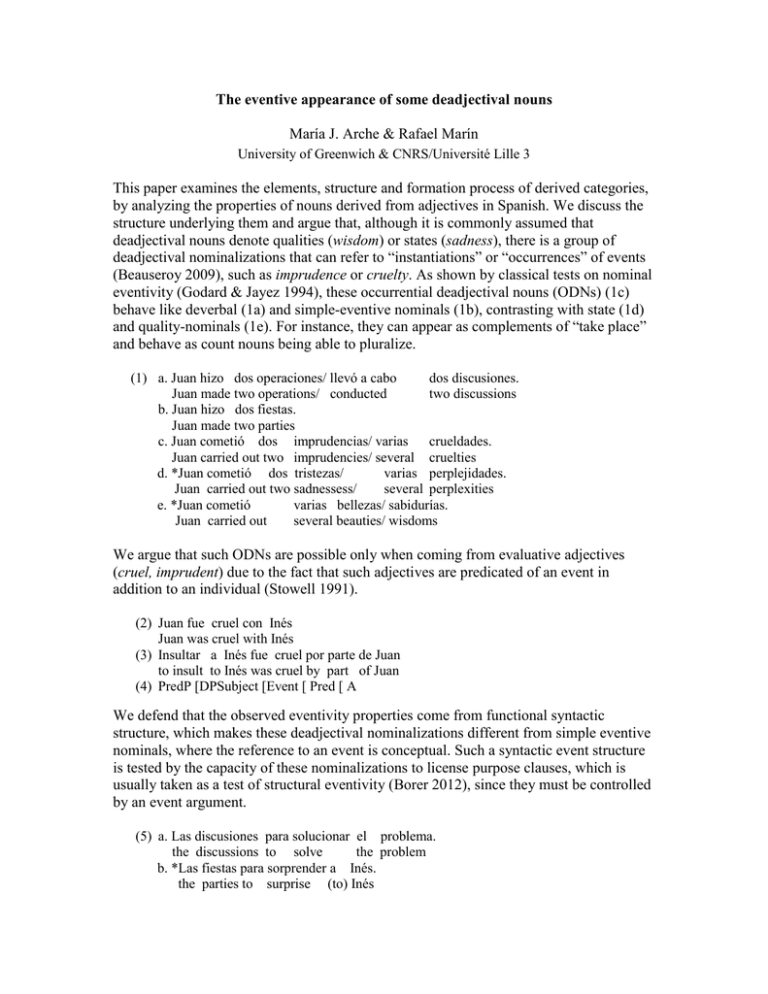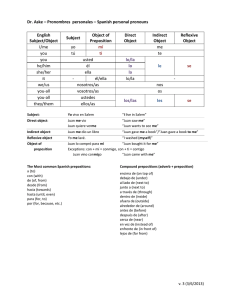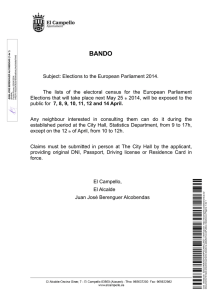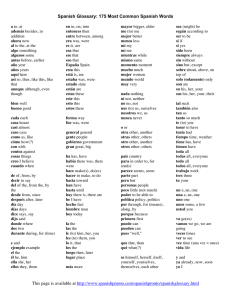The eventive appearance of some deadjectival nouns María J
Anuncio

The eventive appearance of some deadjectival nouns María J. Arche & Rafael Marín University of Greenwich & CNRS/Université Lille 3 This paper examines the elements, structure and formation process of derived categories, by analyzing the properties of nouns derived from adjectives in Spanish. We discuss the structure underlying them and argue that, although it is commonly assumed that deadjectival nouns denote qualities (wisdom) or states (sadness), there is a group of deadjectival nominalizations that can refer to “instantiations” or “occurrences” of events (Beauseroy 2009), such as imprudence or cruelty. As shown by classical tests on nominal eventivity (Godard & Jayez 1994), these occurrential deadjectival nouns (ODNs) (1c) behave like deverbal (1a) and simple-eventive nominals (1b), contrasting with state (1d) and quality-nominals (1e). For instance, they can appear as complements of “take place” and behave as count nouns being able to pluralize. (1) a. Juan hizo dos operaciones/ llevó a cabo dos discusiones. Juan made two operations/ conducted two discussions b. Juan hizo dos fiestas. Juan made two parties c. Juan cometió dos imprudencias/ varias crueldades. Juan carried out two imprudencies/ several cruelties d. *Juan cometió dos tristezas/ varias perplejidades. Juan carried out two sadnessess/ several perplexities e. *Juan cometió varias bellezas/ sabidurías. Juan carried out several beauties/ wisdoms We argue that such ODNs are possible only when coming from evaluative adjectives (cruel, imprudent) due to the fact that such adjectives are predicated of an event in addition to an individual (Stowell 1991). (2) Juan fue cruel con Inés Juan was cruel with Inés (3) Insultar a Inés fue cruel por parte de Juan to insult to Inés was cruel by part of Juan (4) PredP [DPSubject [Event [ Pred [ A We defend that the observed eventivity properties come from functional syntactic structure, which makes these deadjectival nominalizations different from simple eventive nominals, where the reference to an event is conceptual. Such a syntactic event structure is tested by the capacity of these nominalizations to license purpose clauses, which is usually taken as a test of structural eventivity (Borer 2012), since they must be controlled by an event argument. (5) a. Las discusiones para solucionar el problema. the discussions to solve the problem b. *Las fiestas para sorprender a Inés. the parties to surprise (to) Inés c. Las travesuras de Juan para the devilries of Juan to sorprender a Inés. surprise (to) Inés At the same time, we argue that the eventive structure is more defective than the one of verbs’ (which includes aspectual projections taking the root), as deadjectival nominalizations are not compatible with aspectual modifiers of the kind of for/inadverbials. This makes these deadjectival nominalizations lie between deverbal and simple-eventive ones (which arguably consist of a root and a nominalizer). (6) a. la discusión de los problemas durante/ *en una hora. the discussion of the problems for/ in an hour b. la construcción del puente en seis meses. the construction of.the bridge in six months c. *la fiesta durante/ en una hora. the party for/ in an hour d. *la imprudencia/ crueldad de Juan durante una hora. the imprudence/ cruelty of Juan for an hour Nouns such as crueldad ‘cruelty’ and imprudencia ‘imprudence’ not only have an occurrential meaning; they also give grammatical results in contexts proper of quality nouns: una persona de una gran crueldad/ imprudencia ‘a person of a great cruelty/ imprudence’. Yet, it is not the case that all ODNs allow for a quality reading; some (travesura ‘devilry’, fanfarronada ‘’boast’) only have an occurrential reading: *una persona de una gran travesura/ fanfarronada ‘a person of a great devilry/ boast’. Likewise, although all ODNs derive from evaluative adjectives, not all nouns built on evaluative adjectives have an occurrential realization. Certain nouns, such as amabilidad ‘kindness’ or cautela ‘caution’ have a quality (una persona de una gran amabilidad/ cautela ‘a person of a great kindness/ caution’) but not an occurrential reading (*Hizo dos amabilidades/ cautelas ‘(S/he) made two kindnessess/ cautions’). These descriptions shed an important finding: all deadjectival nominals denoting instantiations of events come from evaluative adjectives, arguably due to the presence of an event in the structure. Some of these adjectives are ambiguous and can optionally have this event and give rise to ODNs or to Quality-nouns (cruel, cruelty), which is expected under Arche’s (2006) idea that evaluative adjectives can have either an eventive (4) or a dispositional structure (7). Others lack the Q-reading, which suggest that the base structure in (7) is not an option for them. Finally, the third group remains unexplained as gaps in the universe of possible derivations for the moment. (7) PredP [Subject [Pred [A References Arche, M.J. (2006). Individuals in Time. Tense, Aspect and the individual/stage distinction. Amsterdam: John Benjamins. // Beauseroy, D. (2009). Syntaxe et sémantique des noms abstraits statifs. PhD. Diss, Nancy University. // Godard, D. & J. Jayez (1994).Types nominaux et anaphores le cas des objets et des événements. In Cahiers Chronos 1,41-58. // Stowell, T. (1991). “The alignment of arguments in adjective phrases. In Perspectives on Phrase Structure: Heads and Licensing, S. Rothstein (ed.), 105–135. New York: Academic Press.






